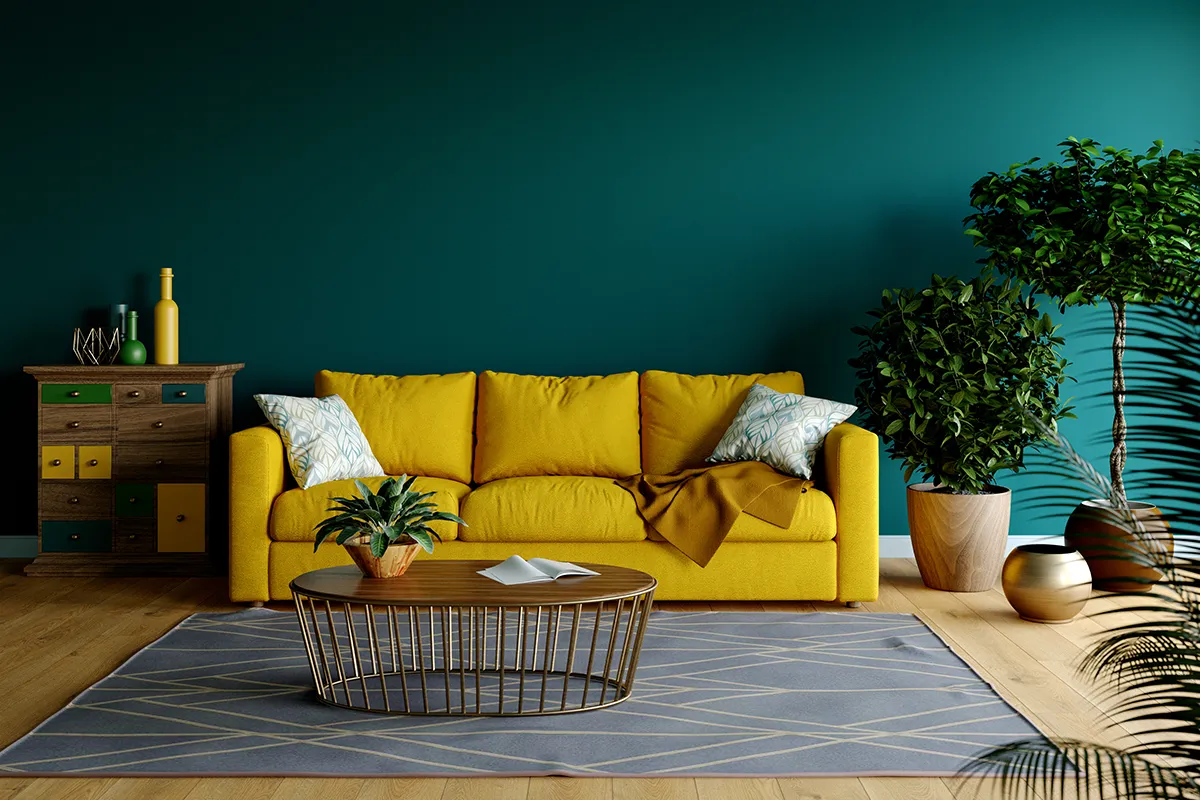Why Colour Matters in Your Home
Colour is more than just a visual choice—it’s a powerful tool that shapes how we feel, think, and live in our homes. The psychology of colour in home design explores how hues influence mood, behavior, and even physical well-being. As someone who’s redecorated my own space (and regretted a few bold choices), I’ve learned that picking the right shade can make or break a room’s vibe. Let’s dive into how colours work their magic and how you can use them to create a home that feels just right.
The Science Behind Colour Psychology
Colour psychology studies how different hues affect human emotions and behaviors. Rooted in biology and culture, colours trigger responses in our brains, influencing everything from stress levels to creativity. In home design, understanding these effects helps you craft spaces that align with your lifestyle and emotional needs.
How Colours Influence Emotions
Each colour has a unique psychological impact. Warm tones like red and yellow energize, while cool tones like blue and green calm. These effects stem from evolutionary cues—like red signaling danger or green evoking nature’s tranquility.
Cultural and Personal Contexts
Cultural backgrounds shape how we perceive colours. For example, white symbolizes purity in Western cultures but is associated with mourning in some Asian traditions. Personal experiences also play a role—my childhood love for sunny yellows still makes me smile in a bright kitchen.
Warm Colours: Energy and Comfort
Warm colours—reds, oranges, and yellows—bring vibrancy and coziness to a home. They stimulate energy and social interaction, making them ideal for spaces where you entertain or create. But overuse can feel overwhelming, so balance is key.
Red: Passion and Power
Red is bold, sparking excitement and appetite. It’s perfect for dining rooms or accent walls but can feel intense in large doses. My friend once painted her living room red and loved the drama—but needed neutral furniture to tone it down.
Orange: Warmth and Creativity
Orange blends red’s energy with yellow’s cheer, fostering creativity and warmth. It’s great for home offices or kids’ rooms. I used a soft peach in my study, and it’s surprisingly uplifting without being too loud.
Yellow: Joy and Optimism
Yellow radiates happiness, making it ideal for kitchens or breakfast nooks. However, bright yellows can strain the eyes if overused. A pale buttery shade in my hallway always feels like a warm hug on dreary days.
Cool Colours: Calm and Serenity
Cool colours—blues, greens, and purples—create soothing, reflective spaces. They’re perfect for bedrooms or bathrooms where relaxation is the goal. These hues lower heart rates and promote peace, but too much can feel cold or detached.
Blue: Tranquility and Trust
Blue is a go-to for calm, trusted spaces like bedrooms or home offices. Studies show it can lower blood pressure. I painted my bedroom a soft blue, and it’s become my sanctuary after chaotic workdays.
Green: Balance and Renewal
Green, tied to nature, promotes balance and focus. It’s versatile for living rooms or studies. A friend’s sage-green living room feels like a forest retreat, perfect for unwinding with a book.
Purple: Luxury and Creativity
Purple evokes royalty and imagination, ideal for creative spaces or elegant bedrooms. Lighter shades like lavender work best in homes to avoid feeling heavy. A lilac accent wall in my guest room always gets compliments.
Neutral Colours: Versatility and Timelessness
Neutrals—whites, grays, beiges, and browns—offer flexibility and sophistication. They act as a backdrop, letting furniture or accents shine. Neutrals are my go-to when I want a room to feel timeless yet adaptable.
White: Clarity and Space
White opens up spaces, making them feel airy and clean. It’s ideal for small rooms or minimalist designs. My white kitchen feels bigger than it is, though I’ve learned to add colorful accents to avoid sterility.
Gray: Modern and Subtle
Gray is a modern favorite, offering a sleek, neutral base. Light grays feel calm, while darker ones add drama. I once used charcoal gray in a bathroom—chic but a bit moody without bright lighting.
Beige and Brown: Warmth and Stability
Beige and brown evoke earthiness, grounding a space. They’re great for cozy living rooms. My brown leather sofa paired with beige walls feels like a warm embrace, especially in winter.
Choosing the Right Colour for Each Room
Selecting colours depends on a room’s purpose, size, and lighting. Here’s a breakdown to guide your choices:
| Room | Best Colours | Why It Works | Tips |
|---|---|---|---|
| Living Room | Green, Beige, Soft Blue | Promotes relaxation and socializing | Use bold accents for energy |
| Bedroom | Blue, Lavender, White | Encourages rest and tranquility | Avoid bright reds or yellows |
| Kitchen | Yellow, White, Red | Stimulates appetite and energy | Pair with neutral cabinets for balance |
| Home Office | Green, Orange, Gray | Boosts focus and creativity | Use natural light to enhance mood |
| Bathroom | White, Blue, Green | Creates a spa-like, calming atmosphere | Add texture to avoid a sterile look |
Living Room: The Heart of the Home
The living room is where you connect with family or guests, so choose colours that encourage warmth and conversation. A soft green or beige works well, with bold accents like mustard pillows for flair. My living room’s sage walls make every movie night feel cozy.
Bedroom: Your Personal Oasis
Bedrooms should prioritize rest, so cool tones like blue or lavender are ideal. A friend’s navy bedroom feels like a cocoon, but she added white bedding to keep it airy. Avoid overly stimulating colours like bright red here.
Kitchen: Energy and Appetite
Kitchens thrive with warm colours like yellow or red to spark appetite and energy. My sunny yellow backsplash makes morning coffee feel like a burst of optimism. Pair with white or gray for balance.
Home Office: Focus and Productivity
For home offices, green or orange boosts focus and creativity. I painted my workspace a soft terracotta, and it’s helped me stay energized during long work hours. Ensure good lighting to avoid a dull vibe.
Bathroom: Serenity and Cleanliness
Bathrooms benefit from spa-like colours—white, blue, or green. A pale aqua in my bathroom feels refreshing, like a dip in a cool pool. Add plants or textured towels for warmth.
Pros and Cons of Using Bold vs. Neutral Colours
Choosing between bold and neutral colours depends on your style and goals. Here’s a comparison:
Bold Colours
Pros:
- Add personality and energy.
- Create focal points or dramatic effects.
- Stimulate creativity and mood.
Cons:
- Can overwhelm small spaces.
- May clash with furniture or decor.
- Risk feeling dated over time.
Neutral Colours
Pros:
- Timeless and versatile.
- Make rooms feel larger and brighter.
- Easy to pair with bold accents.
Cons:
- Can feel bland without texture or accents.
- May lack personality if overused.
- Require frequent cleaning (especially white).
I’ve learned that mixing bold accents—like a teal throw blanket—with neutral walls strikes the perfect balance. It’s like adding a spicy kick to a comforting dish.
Practical Tips for Applying Colour Psychology
Ready to transform your home? Here are actionable tips to use colour psychology effectively:
- Test Swatches: Paint small patches on your walls to see how colours look in different lighting. I once chose a gray that looked perfect in the store but turned purple in my living room’s light.
- Use the 60-30-10 Rule: 60% of the room should be a dominant colour (walls), 30% a secondary colour (furniture), and 10% an accent (decor). This keeps things balanced.
- Consider Lighting: Natural light enhances warm tones, while artificial light can make cool tones pop. Test colours at different times of day.
- Add Texture: Pair colours with textures like wood, linen, or metal to add depth. My beige living room felt flat until I added a woven rug.
- Start Small: Nervous about bold colours? Use them in accents like cushions or artwork before committing to walls.
For tools, check out Behr’s ColorSmart or Sherwin-Williams’ ColorSnap Visualizer to preview colours in your space. Local stores like Home Depot or online retailers like Wayfair offer paint and decor to bring your vision to life.
People Also Ask (PAA) Section
What is the best colour for a calming home environment?
Soft blues, greens, and lavenders are ideal for creating calm. Blue lowers stress, while green evokes nature’s peace. Try a pale blue bedroom for restful vibes.
How do I choose a colour scheme for my home?
Start with your favorite colour, then use a colour wheel to find complementary or analogous shades. Test swatches and consider room function—calm for bedrooms, lively for living rooms.
What colours make a room feel bigger?
White, light gray, and pale blue reflect light, making spaces feel larger. Mirrors and minimal furniture enhance this effect. My white kitchen feels twice its actual size.
Where can I find colour inspiration for home design?
Browse Pinterest or Houzz for ideas. Visit local showrooms or check out Dulux’s colour trends for expert-curated palettes.
FAQ Section
Q: How does colour psychology affect home design?
A: Colour psychology uses hues to influence mood—blues calm, reds energize. In home design, it helps create spaces that align with your emotional and functional needs.
Q: What are the best colours for small spaces?
A: Light colours like white, pale gray, or soft blue make small rooms feel larger. Add mirrors and declutter to enhance the effect, as I did in my tiny apartment.
Q: Where can I buy quality paint for home design?
A: Retailers like Home Depot, Lowe’s, or Farrow & Ball offer high-quality paints. Online tools like Behr’s ColorSmart help visualize choices.
Q: Can bold colours work in every room?
A: Bold colours like red or orange work in social spaces like kitchens but can overwhelm bedrooms. Use them as accents in calmer rooms for balance.
Q: How do I avoid colour mistakes in home design?
A: Test swatches, follow the 60-30-10 rule, and consider lighting. My red accent wall looked great in theory but clashed until I paired it with neutral decor.
Bringing It All Together
Colour is the heartbeat of home design, turning blank walls into spaces that inspire, comfort, or energize. Whether it’s the soothing blue of a bedroom or the lively yellow of a kitchen, every hue tells a story. My own journey with colour—from a regrettable neon orange bathroom to a serene green living room—taught me that intention is everything. By understanding colour psychology, testing your choices, and balancing bold with neutral, you can create a home that’s not just beautiful but deeply personal. Ready to pick up a paintbrush? Share your colour stories in the comments—I’d love to hear what hues make your home sing!


